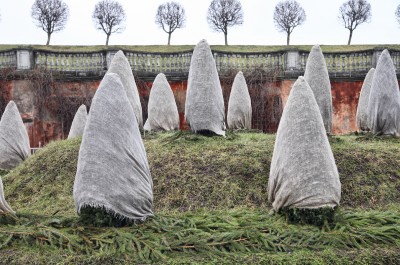






Wrapping plants with burlap is a relatively simple way to protect the plants from winter frost, snow and ice. Read on to learn more.
Covering plants with burlap can also protect plants from winter burn, a damaging condition caused by a combination of winter sunlight and depleted soil moisture. Burlap is more effective than plastic because it allows the plant to breathe so air circulates and heat isn’t trapped.
Burlap for protecting plants can be as simple as an old burlap bag. If you don’t have access to burlap bags, you can purchase sheet burlap by the yard at most fabric stores.
To cover a plant with burlap, begin by placing three or four wooden or stakes around the plant, allowing a few inches of space between the stakes and the plant. Drape a double layer of burlap over the stakes and secure the material to the stakes with staples. Don’t allow the burlap to touch the foliage; if it becomes wet and freezes, it can damage the plant.
Remove the burlap as soon as the weather moderates, but leave the stakes in place so you can cover the plant quickly in the event of another cold snap. Remove the stakes in spring when you’re sure freezing weather has passed.
Not all plants require protection during the winter. If your climate is mild or if winter weather includes only occasional light frost, your plants may need no protection other than a layer of mulch. However, burlap is handy to have around in the event of an unexpected dip in temperatures.
The need for protection also depends on the type of plant. For example, many perennials are hardy in winter, but even hardy plants may be damaged if they aren’t healthy or if they are planted in soggy, poorly drained soil.
Often, newly planted shrubs and trees benefit from protection for the first one to three winters, but are winter-tolerant once they are well established. Broadleaf evergreen shrubs such as azaleas, camellias, rhododendrons often require covering during extreme cold.
Potted plants, which are more susceptible to cold, may need several layers of burlap to protect the roots.
Copyright © www.100flowers.win Botanic Garden All Rights Reserved